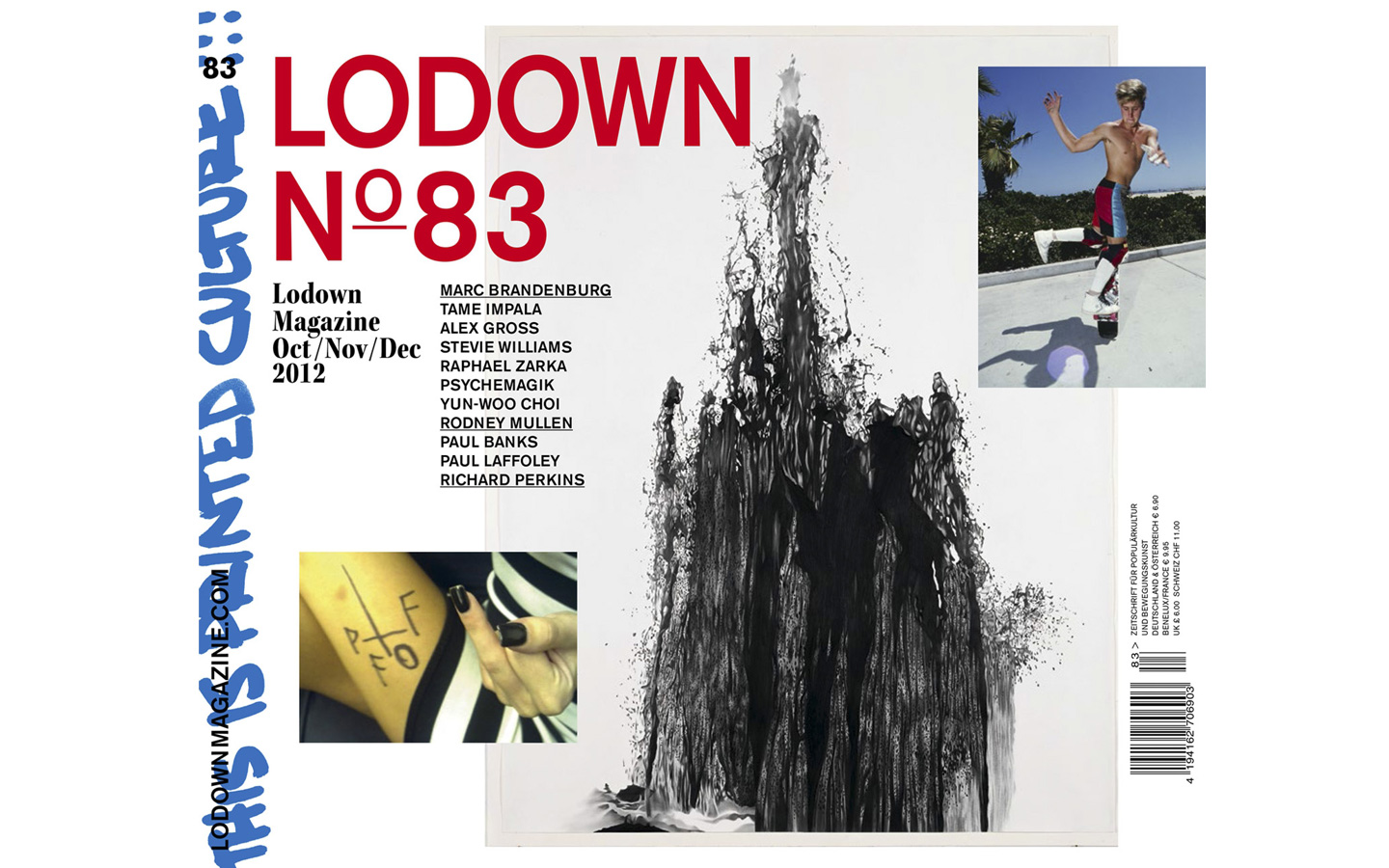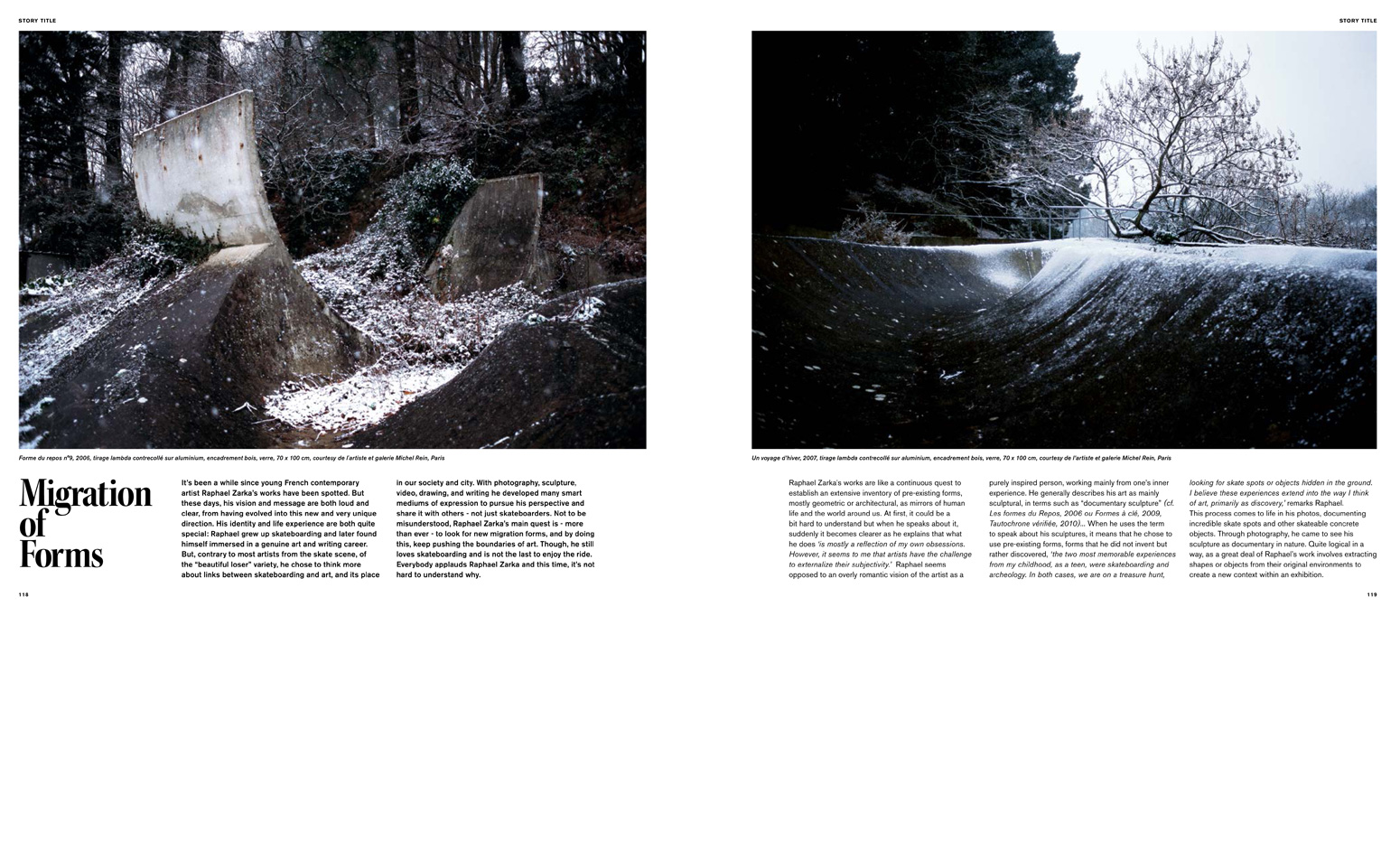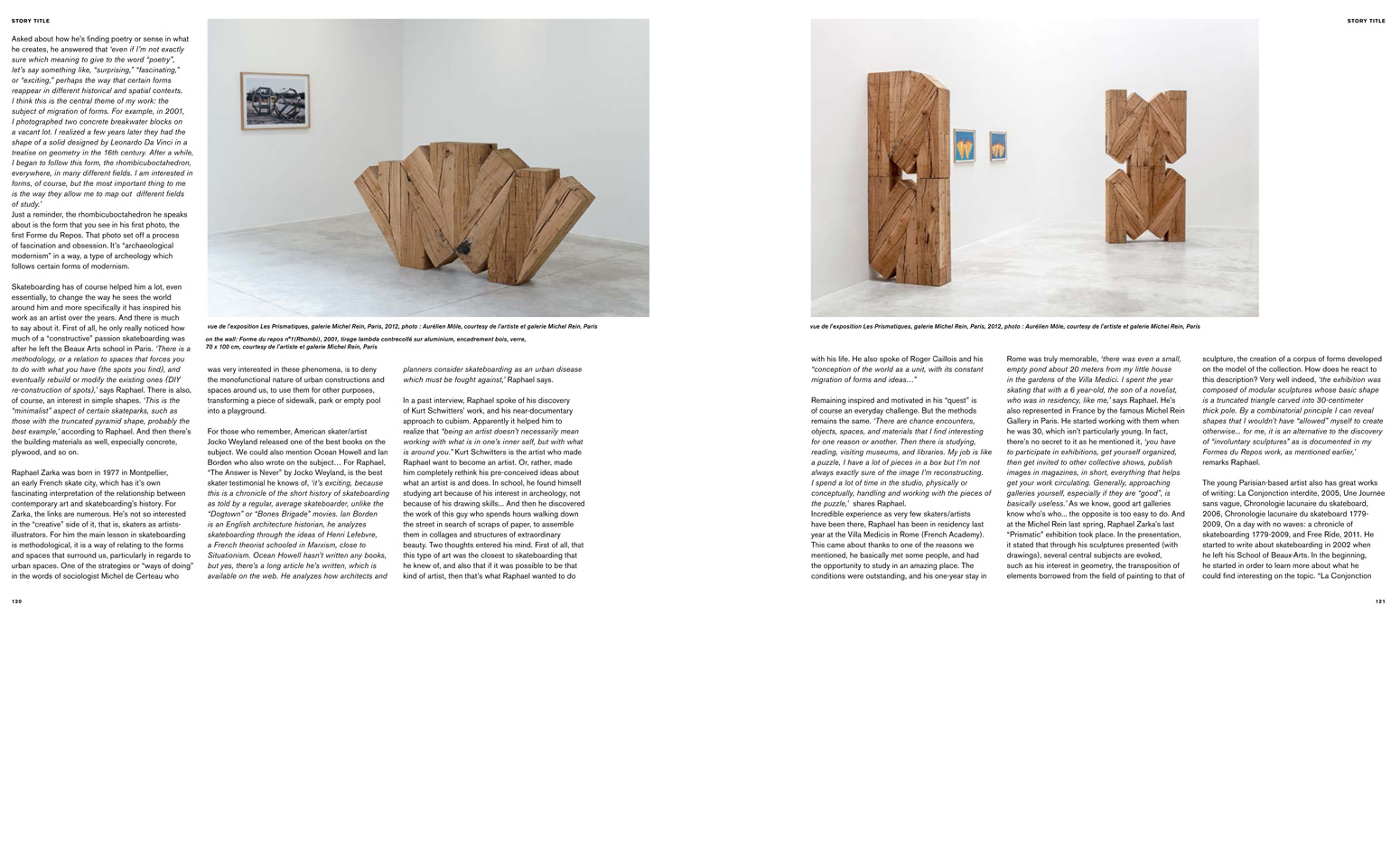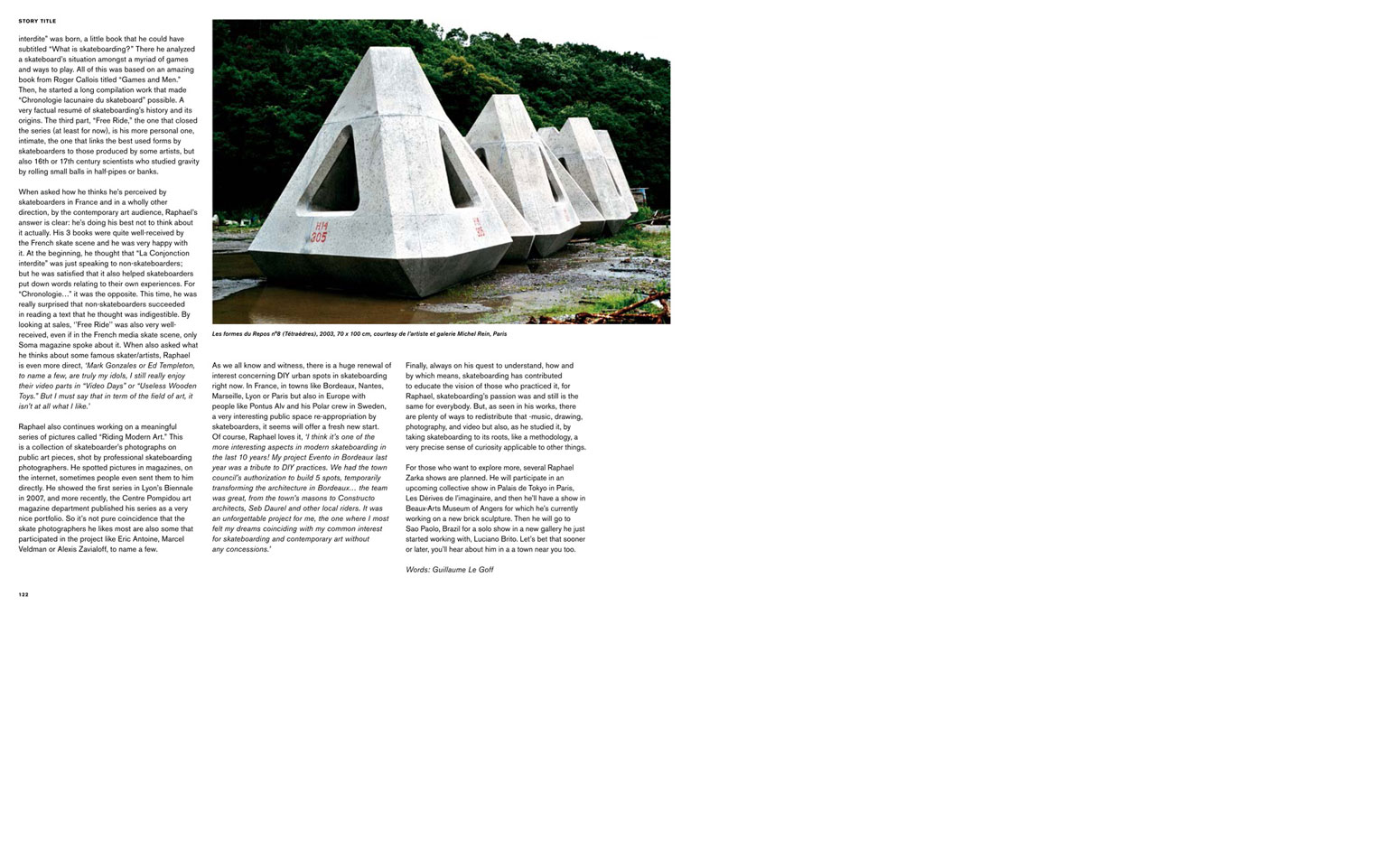ITW Raphaël Zarka
LODOWN MAGAZINE
Your work - through photography, video, sculpture, drawing and writing - is akin to perpetual research in order to establish a vast and rich inventory of pre-existing forms, essentially geometric or architectural, which are ultimately as much Mirrors of the world and the humans who live there and shape it, what would you say?
-
My work is mostly the mirror of my own obsessions. However, the challenge for an artist seems to me to turn his subjectivity to the outside. I am opposed to a too romantic vision of the artist as an inspired person, working essentially from his interiority.
You thus describe your artistic practice as mainly sculptural ("documentary sculpture") through your creations (see The forms of rest, 2006 or Key forms, 2009, Tautochrone verified, 2010) ... Could you explain your stp approach?
-
When I use the term documentary to qualify my sculptures, it implies that I work voluntarily from pre-existing forms, shapes that I do not invent but that I discover. The two outstanding experiences of my adolescence are skateboarding and archeology. In both cases, one is looking for treasures, spots or hidden objects in the earth. I believe that these experiences extend in my view of art mainly as a discovery.
How was this approach born? Did it come after your photos of improbable skate spots and other skateboarding concrete objects?
-
Yes it is through photography that I came to consider my sculpture as a documentary. For me it's quite logical. Much of my work consists in extracting shapes or objects from their original context and recontextualizing them within an exhibition.
What do you find poetic in these forms that you photograph or create?
-
What is poetic (I do not really know what meaning to give to this word, but say something astonishing, exciting, exciting ...) is the way in which certain forms resurface in very historical and spatial contexts. different. I think this is the central aspect of my work: the issue of form migration.
For example, in 2001, I photographed two breakwaters on a vacant lot. I realized a few years later that they had the shape of a solid drawn by Leonardo da Vinci in a 16th century treatise on geometry. Gradually, I began to follow this form, the rhombicuboctahedron, everywhere, in very different areas. The form interests me of course, but the most important is the path it allows me to draw across very different areas.
As a reminder, the rhombicuboctahedron is the shape that we see in my first photograph, the first form of rest. It is after the process of fascination and obsession has been built. It is a kind of "archam-modernism" work, an archeology of certain forms of modernism.
How did the practice of skateboarding help you to have another look at the world around you, and more precisely how it has nourished your work throughout these years (see preface to "The conjunction ...")?
-
There would be a lot to say on this subject ... First of all, I think that I did not realize that afterwards, leaving the school of the fine arts of Paris, how skate was a passion "trainer ". First of all, there is a methodology, or a relation to the worlds, which consists first of all in doing with (the spots found), then possibly in reconstructing (the spots built) or modifying the existing ones (the modifications of spots in the kind of DIY). There is also, of course an interest for simple forms, it is the "minimalist" aspect of skateparks whose truncated pyramid is the best example. There are still the materials, the concrete especially, the plywoods and so on.
What are the links between the history of contemporary art and the history of skateboarding as you studied them?
-
The links between contemporary art, its history and that of skateboarding are multiple. Those who interest me are not on the "creative" side of skaters as illustrator artists. The main lesson of skateboarding, as I said above, is methodological, it is a way of being with respect to forms and spaces that surround us, particularly with respect to forms and urban spaces. One of the strategies or "ways of doing" to use the words of Sociologist Michel de Certeau, who was very interested in these phenomena, is to refuse the monofunctionality of street furniture and the spaces that surround us, to use them for other purposes, transforming a piece of pavement, a parking lot or an empty swimming pool into a vector of play and pleasure.
I remember you quoted a Jocko Weyland book about skateboarding as one of the best on
What continues to motivate you and guide you in your artistic quest for these timeless forms? And how do you feed it "differently" on a daily basis, in the long run?
-
The methods remain the same. There are the chances of encounters, objects, spaces of materials that I discover and that appeal to me for whatever reason. Then there is study, reading, visiting museums and libraries. My work is a bit like a puzzle, I have lots of pieces in a box but I'm not sure of the image that needs to be reconstructed. I spend a lot of time in the workshop manipulating, materially or conceptually, the pieces of the puzzle.
You have been a resident of the Villa Medicis in Rome (French Academy), few artists / skaters to have been I suppose ... How does it happen and what did it bring you?
-
For the reasons I have just mentioned, the chances of meetings, and the opportunity to study under remarkable conditions, this one-year stay in Rome was unforgettable. There was even a small empty pool 20 meters from my pavilion in the garden of the Villa Medici, I spent the year skating it with a 6-year-old skater, the son of a novelist, boarder like me. You see, it's not just art and books at Villa Medici.
You are represented in France by the Michel Rein gallery in Paris. Can you tell us more about it ?
-
I started working with a gallery, Michel Rein precisely, at 30, which is not particularly early. In fact, there is no secret, it is necessary to make expos, to organize oneself first, then to be invited in other collective exhibitions, to publish images in magazines, in short, all that makes work circulate. Generally, to go to galleries, especially if they are "good", it is useless, the good galleries locate the artists ... the reverse is too easy to do!
Your last exhibition "The Prismatic" took place last spring and we can read in the presentation that, through the sculptures presented (accompanied by drawings), several central questions came together as your "interest in geometry , the transposition of elements borrowed from the field of painting to that of sculpture, the constitution of a corpus of forms developed on the model of the collection "...
-
The exhibition was composed of modular sculptures whose basic form is a truncated rectangle triangle cut into a beam 30 cm in diameter. By a combinatorial principle I can discover forms that I could not "afford" otherwise ... For me it is an alternative to the discovery of "involuntary sculptures" that document the Forms of Rest that we mentioned above .
You also have an important work of author (The Forbidden Conjunction, 2005, A Day Without Wave, Lacunary Skateboarding Chronology, 2006, Lacunae Chronology of Skateboarding 1779-2009, On a day with no waves: a chronicle of skateboarding 1779- 2009, Free Ride, 2011) ... Can you tell us about this work and describe what corresponds to each book in terms of research?
-
I started writing on skateboarding in 2002 when I graduated from the Ecole des Beaux-Arts. At first it was to understand what I could find so important ... It gave The Forbidden Conjunction which is a small book that I could subtitled "What is skateboarding? ". I analyze the place of skateboard among the diversity of games and ways of playing. This from an exciting book by Roger Caillois: The Games and Men. Then, I embarked on a long compilation work that gave the Lacunary Chronology of Skateboarding. A factual account of the history of skateboarding since its origins. The third part, Free Ride, the one that closes (at least temporarily), and the one that seems to me the most personal, which links the forms used by skaters to those that some artists have produced, but also scientists from 16 and 17th century who studied the laws of falling bodies by rolling logs on small half-pipes or inclined planes.
How do you think you are perceived by the skateboard public and in the other direction by the public of contemporary art?
-
I do my best not to think about it too much. The fact that my 3 books are rather well received by the skate community francophone, really pleased me. Initially, I thought that The Forbidden Conjunction was aimed primarily at those who do not know anything about skateboarding; I was happy that this text seems to help some skaters to put words on their own experience. For the Chronology, my feeling was the opposite. This time, what surprised me was that non skaters managed to read this text that I thought was indigestible. If I judge by the sales, Free Ride is welcomed too, even if, in the skateboarding world, Soma is the only skate magazine to have devoted a chronicle to him.
You seem well placed to give me also your opinion on it: how contemporary art, its artists, its elites, its critics, its galleries, its diverse and varied actors, see the world of skateboarding and certain artistic forms that it generates since a few?
-
Mark Gonzales, Ed Templeton, these are my idols, I still watch their shares in Video Days or Useless Wooden Toys. But I must say that this is not at all what fascinates me in the field of art.
You said in this interview that "finally, I still have to understand how, by what means, the skateboard could shape the eyes of those who practiced it" ... Where are you today?
-
I think that the passion was the same for everyone, but that there are lots of ways to redistribute it: music, drawing, photography, video, but also, as I have said many times, take skateboarding at the root, as a methodology, a keen sense of curiosity applicable to anything else.
What did you think of the "Public Domain" event last year at La Gaité Lyrique?
-
I was in Rome during "Public Domain", so I missed the show. But the returns I got were not famous. For me it is forever the update of "Beautiful Losers" and there is so much more to do from skateboarding. An example: the photographs of Eric Antoine, whose images I love, were presented on LCD screens ... While Eric uses only film camera and does all his prints himself. It does not make sense, really. This is just an example and again I do not criticize the works or the images per se, but simply the uniformity of an exhibition on or around the skateboarding culture.
There was also this exhibition at the Palais de Tokyo in Paris with this monumental work by Ulla von Brandenburg "Death of a King", a large and beautiful work in the form of a painted ramp, forbidden to skate but open to children to play, this who did (a little) controversy in the skateboarding world in France ... What do you think?
-
A controversy, really? I did not know, it's all the same exaggerated?
It is a scene, a podium with curved walls that is of course inspired by the shape of the skate ramps. It's a pity that she is not skate, but it's not the end of the world either! And all the installations with curved shapes do not have to be skatable so far ... For some years, from Sim Parch to Koo Jong on the island of Vassivière through the spot Peter Kogler door Ivry in Paris , the ramp of Michel Majerus which was this summer at the CAPC museum in Bordeaux, sculptures / installations skatables do not miss!
Can you tell us about your work of "Riding Modern Art" (see the Flame of Freedom, 1987 ...)?
-
Yes, it's a collection of skateboarding photographs of public artwork taken by professional skate photographers. I see them in magazines, on the internet, sometimes they send me directly. I have exhibited at the Biennale de Lyon in 2007, more recently, the review of art history Center Pompidou had proposed me to design a portfolio and I have published this collection.
What are your favorite skate photographers?
-
Eric Antoine, Marcel Veldman Alexis Zavialoff ... To limit myself to those who participated in the project Riding Modern Art.
What is your view on the current interest in DIY concrete spots with what is happening in Bordeaux, Nantes, Marseille, but also with people like Pontus Alv in Sweden? So many new forms of reappropriation of public space ...
-
I love it, I think it's one of the most interesting aspects of skateboarding in the last 10 years. My project for the Evento festival in Bordeaux, was a tribute to these DIY practices. We had permission from the town hall to build 5 spots by temporarily changing the architecture of Bordeaux ... The team was extra, the masons of the city of Bordeaux, the architects of Constructo, Seb Daurel and other local skaters ... C is an unforgettable project for me, the one where I felt the best that I managed to make coincide my interest in skateboarding and contemporary art without any form of concession.
And in music, what do you like to listen to?
-
I started listening to Lo-Fi, Lou Barlow, Beat Happening etc. Let's say I basically listen to music with guitars ... My two favorite singers are Bill Callahan and Will Oldham. I really like Jonathan Richman too.
To this day, what are you working on and what are your plans?
-
Several upcoming exhibitions: I take part in the next collective exhibition at the Palais de Tokyo, The Dérives of the Imaginary, then I have an exhibition at the Museum of Fine Arts in Angers for which I am working on a new brick sculpture. Then I go to Brazil, to Sao Paolo for a personal exhibition at the Luciana Brito gallery with which I work now.
Writer
CLIENT: Lodown Magazine DATE: 2012 


